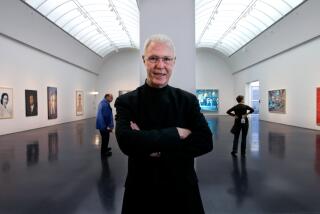Remembering the Cannes of a Long-Gone Era
- Share via
The Cannes Film Festival does not start until the second week in May. But for years, when I was a regular attendee, the idea of the festival began to seem wonderful as early as Christmas.
It was crazy because each year when I came home, red-eyed and pale from having seen all or part of four or five dozen films in two weeks, I would swear never to go again. (I once noted that at Cannes our set never suns.)
I would remember trying to thread my way along the Croisette past French day-tippers (who walk with an infuriating slow shuffle that is the nearest thing to no movement at all) and stumbling over the leashes of their small, incontinent dogs.
The haste would be only to join a horde of heaving, pushing and uncivil alleged journalists from everywhere on earth, performing like lemmings desperate to be first over the cliff into the sea but blocked by unsmiling door guards who, if they had their way, would have all films projected to empty cinemas.
In the days just after the festival I would remember the extortionate prices, the frustrations of filing copy, the hypes and the importunings of desperate film makers with a work (screening at midnight in the hills) that cried to be seen.
But by early January the good memories would reassert themselves. Roger Ebert, the cinematic oracle of television with the eloquent thumb, has now celebrated the (mostly) good and amusing aspects of the festival in a charming little book, “Two Weeks in the Midday Sun: A Cannes Notebook” (Andrews and McMeel, $8.95). It is illustrated by his scraggly line drawings, which indicate why he is a writer by profession.
The notebook specifically reports the 1987 gathering, which was graced by “Dark Eyes,” “Shy People,” “Barfly” and “Attack of the Killer Bimbos.” But Ebert is really presenting a more general account of Cannes, and particularly of the festivals of the mid-’70s, when it was graced by the presence of our mutual friend Billy Baxter, to whom the book is dedicated.
Billy, who then did high-level public relations of some sort for Philip Morris, was by his own choice a kind of parody of the loud American. He arrived with a heavy trove of silver dollars that he distributed as freely as lapel pins and that were prized by the locals for their novelty as well as their value.
He called all waiters “Oiving” and summoned them in a cheerful bellow, crying, “Brang ‘em on.” He did his best to exhaust the Majestic Hotel’s supply of Red Label whisky, and there were moments when he threatened to succeed.
No one is known to have signed a bar chit in his presence, although he had a sixth sense for outriders who were invading the large but well-defined circle of his pals just to enjoy Billy’s open-handedness. But his hostilities could be as marked as his generous enthusiasms.
One year he set upon and wrestled to the marble floor of the Carlton Hotel lobby an American festival organizer who some years earlier had in Billy’s view slighted the beautiful woman, a critic, who was then the love of Billy’s life. The festival man, falling, cried, “My $300 cashmere jacket!” No damage was done to the jacket or human life, but honor was served.
Billy was avocationally also a film distributor, who had the rights to one or more of Lina Wertmuller’s early films and who one year acquired “Outrageous,” the small, fine Canadian film about the private life of a female impersonator.
Beneath the bombast Billy was and is a sensitive man as well as a born survivor of some hard early days. When he stopped coming to Cannes, the festival stopped being the same kind of affectionate alumni reunion it had been.
Ebert, who is something of a loner, always stays at the Hotel Splendid, a smaller institution that is now close by the new Palais du Festival, though in earlier days it was usefully far from the madding crowds.
Some of the most evocative passages in Ebert’s book are his celebrations of his early morning strolls for coffee and brioche at the sidewalk cafes on the streets inland from the elegant boulevard, the Croisette. As most festival regulars do, Ebert appreciates what can be called the real Cannes, which has a useful and productive life the other 50 weeks of the year.
The festival seems to grow larger and more frenetic each year. The new Palais, in Nazi Bunker Moderne, has the charm of a state office building. Glamour is an item of memory. The cocktail lounges resemble delis at high noon.
But, frenzies and all, Ebert brings it seductively back. I talked to Billy the other day and he is thinking about going again. I may have to rethink the matter myself.
More to Read
Only good movies
Get the Indie Focus newsletter, Mark Olsen's weekly guide to the world of cinema.
You may occasionally receive promotional content from the Los Angeles Times.









